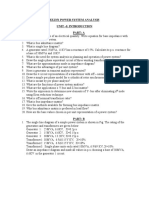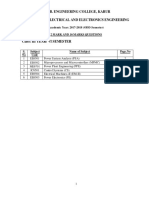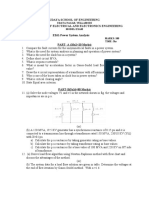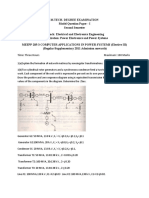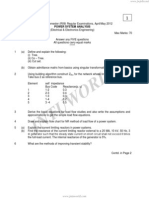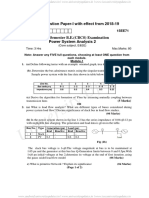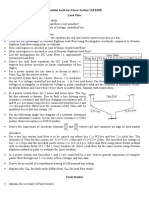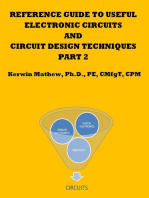PEE212 Tut Sheets 1-8 PDF
PEE212 Tut Sheets 1-8 PDF
Uploaded by
Arash GhumanCopyright:
Available Formats
PEE212 Tut Sheets 1-8 PDF
PEE212 Tut Sheets 1-8 PDF
Uploaded by
Arash GhumanOriginal Title
Copyright
Available Formats
Share this document
Did you find this document useful?
Is this content inappropriate?
Copyright:
Available Formats
PEE212 Tut Sheets 1-8 PDF
PEE212 Tut Sheets 1-8 PDF
Uploaded by
Arash GhumanCopyright:
Available Formats
THAPAR UNIVERSITY, PATIALA
ELECTRICAL AND INSTRUMENTATION ENGINEERING DEPARTMENT
Subject: FACTS CONTROLLERS AND MODELING (PEE212) Course Instructor: Parag Nijhawan
Semester: Jan.-June, 2016 Class: M.E. 1st Year (Power Systems)
Tutorial Sheet – 1
1) What is the need of ‘Reactive Power Compensation’?
2) What are the various conventional compensating devices used in a power system network?
Discuss the role of each.
3) What are the limitations of conventional compensating devices?
4) Prove that active power is a function of voltage phase angle and reactive power is a function of
voltage magnitude.
5) A 150MVA load with power factor of 0.75 is connected to the power system network. What
rating of capacitor is required to improve its power factor to 0.95?
6) An a.c. source is supplying a resistive load of 80Ohms through a line of impedance (4+j30)Ohms,
what will be the source voltage needed to maintain load voltage of 33kV? Now, if an j80 Ohm
reactor is added in parallel to the resistive load, what will be the circuit current, and source
voltage needed to maintain the same load voltage?
THAPAR UNIVERSITY, PATIALA
ELECTRICAL AND INSTRUMENTATION ENGINEERING DEPARTMENT
Subject: FACTS CONTROLLERS AND MODELING (PEE212) Course Instructor: Parag Nijhawan
Semester: Jan.-June, 2016 Class: M.E. 1st Year (Power Systems)
Tutorial Sheet – 2
1) A three-phase transmission line has a resistance of 12 Ohms/phase and a reactance of 35
Ohms/phase. Determine the maximum power which may be transmitted if 132kV were maintained
at each end. What is the phase difference between the receiving end and sending end voltages for
maximum power transmitted? Also, determine the rating of a SPM required to supply 100MW at 0.9
power factor lagging at the receiving end.
2) A three-phase overhead line resistance and reactance per phase of 20 Ohms and 80 Ohms,
respectively. The sending end voltage is 145kV, while the load end voltage is maintained at 132kV
for all loads by an automatically controlled SPM. If the MVAR of the modifier has the same value for
zero load as for a load of 50MW, find the rating of the modifier and the power factor of this load.
3) A 320km, 275kV, three-phase line has the following general parameters:
A = 0.94 1o, B = 107 78o Ohms
If the receiving end voltage is 275kV, determine (i) the sending end voltage necessary if a load of
300MW at 0.9 lagging power factor is being delivered at the receiving end, (ii) the maximum power
that can be transmitted if the sending end voltage is held at 290kV, (iii) the additional reactive MVA
that will have to be provided at the receiving end when delivering 450MVA at 0.9 lagging power
factor, the supply voltage being 290kV.
4) A three-phase 50Hz transmission line has resistance of 14 Ohms and an inductive reactance of 48
Ohms/phase. The capacitive susceptance to neutral is 4x10-4 Siemens. Find the MVAR rating on no
load and full load of a SPM to maintain the sending end and receiving end voltages at 70kV and
66kV, respectively, when the line is delivering a load of 24MVA at 0.8 power factor lagging. Use
nominal-π equivalent circuit for solution.
THAPAR UNIVERSITY, PATIALA
ELECTRICAL AND INSTRUMENTATION ENGINEERING DEPARTMENT
Subject: FACTS CONTROLLERS AND MODELING (PEE212) Course Instructor: Parag Nijhawan
Semester: Jan.-June, 2016 Class: M.E. 1st Year (Power Systems)
Tutorial Sheets – 3 & 4
1) What is the need of FACTS technology?
2) Discuss the classification of FACTS devices.
3) How converter based FACTS devices are superior to thyristors based FACTS devices?
4) Draw the block diagrams of STATCOM, SSSC and UPFC. Also, write their applications.
5) Why have distribution systems begin to receive more attention for reliability assessment?
6) What are the reasons behind increasing concerns for power quality? Also, write the causes
behind these reasons.
7) Compare: FACTS devices and Custom Power devices.
8) Explain the operation, structure and applications of DSTATCOM.
9) Explain the operation, structure and applications of DVR.
10) Explain the operation, structure and applications of UPQC.
11) What is an Open UPQC? What is its application?
12) What is an interline DVR? Discuss its operation.
THAPAR UNIVERSITY, PATIALA
ELECTRICAL AND INSTRUMENTATION ENGINEERING DEPARTMENT
Subject: FACTS CONTROLLERS AND MODELING (PEE212) Course Instructor: Parag Nijhawan
Semester: Jan.-June, 2016 Class: M.E. 1st Year (Power Systems)
Tutorial Sheets – 5 & 6
1) Consider a three bus system. The specifications at various buses are given in the table. Carry out
FDLF up to 3 iterations.
Table-1(a):- Line Data
Line No. Bus Code (p-q) Line impedance
1 1-2 j0.25
2 2-3 j0.25
3 3-1 j0.25
Table-1(b):- Input data
BUS BUS TYPE Vi(PU) i Pi Qi
1 Slack bus 1.00 0 - -
2 PQ bus ? ? -0.5 -0.4
3 PV bus 0.90 ? 0.5 -
If a capacitor of reactance –j0.10 is connected in parallel to the PV bus. Compare the LF solution
after providing shunt compensation with that of uncompensated system.
2) Consider three bus systems. The line reactance’s are given in the table-2(a) the line resistances
are neglected. The magnitude of all the three bus voltages is specified as 1.00 pu. The power at
the buses is listed in table-2(b).
Table-2(a):- Line Data
Line No. Bus Code (p-q) Line impedance
1 1-2 j0.2
2 2-3 j0.2
3 3-1 j0.2
Table-2(b):- Input data
BUS REAL LOAD REACTIVE LOAD REAL POWER REACTIVE POWER
DEMAND DEMAND GENERATION GENERATION
1 1.0 0.6 PG1 (Unspecified) QG1 (Unspecified)
2 0.0 0.0 1.4 QG2 (Unspecified)
3 1.0 1.0 0.0 QG3 (Unspecified)
Carry out load flow solution. If now a capacitor of –j0.05 is added between buses 2 and 3, obtain the
modified load flow solution, and draw conclusions.
3) For the system whose data is given below, obtain the load flow solution using FDLF method
(upto 3 iterations). Now, series capacitor is installed in the line between buses 2 and 3 to
compensate 10% reactive power. Use PIM and obtain the load flow solution of the compensated
system (upto 3 iterations). Also, obtain the PIM of series capacitor with 10% reactance variation.
Compare the results obtained for the compensated system with that for the uncompensated
system.
Line data (All quantities are in p.u.)
Line Number Between Buses Line Impedance Half Line charging
admittance
1 1-2 j0.1 0
2 2-3 j0.2 0
3 1-3 j0.3 0
Bus data
Bus No. Type Generator Load Voltage Reactive power
P Q P Q magnitude limit
Qmin Qmax
1 Slack - - - - 1.0 - -
2 P-V 5.3217 - - - 1.1 0 5.3217
3 P-Q - - 3.6392 0.5339 - - -
THAPAR UNIVERSITY, PATIALA
ELECTRICAL AND INSTRUMENTATION ENGINEERING DEPARTMENT
Subject: FACTS CONTROLLERS AND MODELING (PEE212) Course Instructor: Parag Nijhawan
Semester: Jan.-June, 2016 Class: M.E. 1st Year (Power Systems)
Tutorial Sheets – 7 & 8
1) What are SVC systems? Describe the SVC schemes commonly used in EHV/UHV transmission.
2) Explain why static compensation is preferred over synchronous compensation in modern power
systems.
3) State the advantages of SVS over other methods of voltage control. Also, write its applications.
4) What is a TSR? How is it different from TCR?
5) Draw the block diagram and characteristics of STATCOM.
6) How can a STATCOM improve power system performance? Why do we prefer VSC in STATCOMs
instead of CSC?
7) What are the advantages of STATCOM over SVC?
8) How are the output voltage and VAR controlled in a DSTATCOM? Explain, in detail.
9) Derive the PIM of STATCOM.
You might also like
- Tutorial Power System Analysis - Power Flow Analysis-SolutionDocument12 pagesTutorial Power System Analysis - Power Flow Analysis-SolutionAdriana Shoppe67% (3)
- EE2351-Power System Analysis PDFDocument15 pagesEE2351-Power System Analysis PDFRK K0% (1)
- Equations of Motion 2 AnswersDocument2 pagesEquations of Motion 2 AnswersAmelia Rahmawati100% (1)
- O Level Pure Physic - Physics Definition ListDocument5 pagesO Level Pure Physic - Physics Definition ListZeneon90% (10)
- Eee Iii Year 2017-2018Document48 pagesEee Iii Year 2017-2018J JulietNo ratings yet
- Sree Vidyanikethan Engineering College: Code No.Document4 pagesSree Vidyanikethan Engineering College: Code No.Nmg KumarNo ratings yet
- PTEE7403 April 2019Document3 pagesPTEE7403 April 2019imman46920No ratings yet
- Model 1Document2 pagesModel 1ponselvanvNo ratings yet
- Power SystemDocument3 pagesPower SystemMogaka LucasNo ratings yet
- PSS Lab (18EEL76) - Lab - Exam - QPDocument4 pagesPSS Lab (18EEL76) - Lab - Exam - QPkurdso kurizNo ratings yet
- Power System AnalysisDocument5 pagesPower System AnalysisVidyavihar ReddyNo ratings yet
- PSG College of Technology, Coimbatore - 641 004 Semester Examinations, SemesterDocument4 pagesPSG College of Technology, Coimbatore - 641 004 Semester Examinations, SemestermahesNo ratings yet
- Q) A Single-Phase Two-Winding Transformer Is Rated 20 kVA, 480/120 Volts, 60 HZDocument8 pagesQ) A Single-Phase Two-Winding Transformer Is Rated 20 kVA, 480/120 Volts, 60 HZMarwan MohamedNo ratings yet
- Assignments - 1 July-December 2021Document7 pagesAssignments - 1 July-December 2021Ayush AgrwalNo ratings yet
- UEE602 Tut Sheets 1Document12 pagesUEE602 Tut Sheets 1Kulvinder Singh0% (1)
- 14-05 Power System Analysis (EL)Document2 pages14-05 Power System Analysis (EL)Javed samejoNo ratings yet
- Unit I - Introduction Part - A (2 Marks)Document14 pagesUnit I - Introduction Part - A (2 Marks)Ragul RamNo ratings yet
- 07a70202 PowersystemanalysisDocument12 pages07a70202 PowersystemanalysisSamiullah MohammedNo ratings yet
- Power System Analysis ImportantDocument8 pagesPower System Analysis Importantsparkle courageNo ratings yet
- UEE509 Tutorial Sheets and Lab AssignmentsDocument13 pagesUEE509 Tutorial Sheets and Lab AssignmentsAditya AdityaNo ratings yet
- PSS Lab (21EE62) - Batch QuestionsDocument6 pagesPSS Lab (21EE62) - Batch Questionscybermonks222No ratings yet
- EE6501 Power System AnalysisDocument29 pagesEE6501 Power System AnalysisJebastin RohinNo ratings yet
- Power System Analysis April 2018Document8 pagesPower System Analysis April 2018giri manoj sai ram chilukuriNo ratings yet
- Power System Analysis Question Papers (2021-)Document29 pagesPower System Analysis Question Papers (2021-)Jishnuraj KubandrarajNo ratings yet
- EENG 457 Experiment 5Document7 pagesEENG 457 Experiment 5Alexander VoltaNo ratings yet
- EE8501-Power System AnalysisDocument8 pagesEE8501-Power System AnalysisthiyagusuperNo ratings yet
- Pss Lab QuestionsDocument7 pagesPss Lab QuestionsPandyselvi BalasubramanianNo ratings yet
- JNTUA - B Tech - 2018 - 3 2 - May - R15 - EEE - 15A02603 POWER SYSTEM ANALYSISDocument2 pagesJNTUA - B Tech - 2018 - 3 2 - May - R15 - EEE - 15A02603 POWER SYSTEM ANALYSISVinay ChinthaNo ratings yet
- 15ee71 Question Paper VtuDocument5 pages15ee71 Question Paper VtuPuneeth N RanapurNo ratings yet
- WWW - Manaresults.Co - In: Power System AnalysisDocument8 pagesWWW - Manaresults.Co - In: Power System Analysisajay malothNo ratings yet
- IGEE 402 - Power System Analysis Final Examination - Sample Fall 2004Document28 pagesIGEE 402 - Power System Analysis Final Examination - Sample Fall 2004Akinbode Sunday OluwagbengaNo ratings yet
- Power System Previous Question PDFDocument3 pagesPower System Previous Question PDFBijoy ChowdhuryNo ratings yet
- PSA Mid1Document3 pagesPSA Mid1Rajesh BembadiNo ratings yet
- PsocqpDocument3 pagesPsocqpNadeem KhanNo ratings yet
- Power Sytem AnalysisDocument30 pagesPower Sytem Analysisdeenarg18No ratings yet
- Question Paper CodeDocument6 pagesQuestion Paper Codeprasad powerNo ratings yet
- Final Questions EPS-2 - 2019Document17 pagesFinal Questions EPS-2 - 2019punitsompuraNo ratings yet
- IJEEE - Electrical - Analysis of Circuit Breaker Pole Reclosing of - Naveen GaurDocument8 pagesIJEEE - Electrical - Analysis of Circuit Breaker Pole Reclosing of - Naveen Gauriaset123No ratings yet
- Psa (Cia)Document6 pagesPsa (Cia)125159036No ratings yet
- WWW - Manaresults.co - In: Power System AnalysisDocument6 pagesWWW - Manaresults.co - In: Power System AnalysisHyma GelliNo ratings yet
- CAPS Lab ManualDocument18 pagesCAPS Lab ManualAyush NemaNo ratings yet
- ELEG 530 - Project 1 - Fall 2014Document4 pagesELEG 530 - Project 1 - Fall 2014dr_biltNo ratings yet
- Ee8711 Set1Document14 pagesEe8711 Set1St. Anne's CET (EEE Department)No ratings yet
- LFSCDocument79 pagesLFSCIppo MakunouchiNo ratings yet
- Important PSA Assignment PDFDocument27 pagesImportant PSA Assignment PDFDevansh PratapNo ratings yet
- Ee 8501 - Power System Analysis Unit-1 Introduction Part ADocument5 pagesEe 8501 - Power System Analysis Unit-1 Introduction Part AVbalaji VaithiyanathanNo ratings yet
- PSA SolutionDocument5 pagesPSA SolutionviswaNo ratings yet
- Chapter 3-Power Flow Solution-Gauss Seidel 2Document32 pagesChapter 3-Power Flow Solution-Gauss Seidel 2Avianda Sinyo100% (1)
- PS Lab Manual B Tech 2017 18 PDFDocument37 pagesPS Lab Manual B Tech 2017 18 PDFASHUTOSH KrishnavanshiNo ratings yet
- Nr-410204-Power System Operation and ControlDocument8 pagesNr-410204-Power System Operation and ControlSrinivasa Rao GNo ratings yet
- 29.voltage Flicker Compensation Using STATCOMDocument6 pages29.voltage Flicker Compensation Using STATCOMdeepu227No ratings yet
- Eracs ReportDocument16 pagesEracs Reportaaron100% (2)
- Power Systems: KPSC Objective MCQ Series (Topic Wise With Solution)Document30 pagesPower Systems: KPSC Objective MCQ Series (Topic Wise With Solution)Grigesh K MadhavNo ratings yet
- Question Bank Samples For Power System II EE602Document4 pagesQuestion Bank Samples For Power System II EE602AvijitNo ratings yet
- CMPSA Notes 3Document57 pagesCMPSA Notes 3priyanshum230825eeNo ratings yet
- Model Question Paper-I With Effect From 2018-19: Seventh Semester B.E. (CBCS) ExaminationDocument5 pagesModel Question Paper-I With Effect From 2018-19: Seventh Semester B.E. (CBCS) ExaminationVinod KohliNo ratings yet
- 01-BEE4033 EE419-Power Systems-Test 2 QuestionDocument3 pages01-BEE4033 EE419-Power Systems-Test 2 QuestionSalman YusufNo ratings yet
- LOGBOOKDocument29 pagesLOGBOOKAakash SinghNo ratings yet
- PSADocument25 pagesPSAramyadspNo ratings yet
- Power SystemsDocument60 pagesPower SystemsKoustav DasguptaNo ratings yet
- VSC-FACTS-HVDC: Analysis, Modelling and Simulation in Power GridsFrom EverandVSC-FACTS-HVDC: Analysis, Modelling and Simulation in Power GridsNo ratings yet
- Reference Guide To Useful Electronic Circuits And Circuit Design Techniques - Part 2From EverandReference Guide To Useful Electronic Circuits And Circuit Design Techniques - Part 2No ratings yet
- Topic: Moments, Mass Weight Density Name: - Date: - Class: - SectionDocument3 pagesTopic: Moments, Mass Weight Density Name: - Date: - Class: - SectionUsman Ameen50% (2)
- ProjectileDocument40 pagesProjectileSweet EmmeNo ratings yet
- Pharm LabDocument1 pagePharm LabMichelle CasilangNo ratings yet
- CTY-2022-PT-3-Main Paper With AnswerDocument16 pagesCTY-2022-PT-3-Main Paper With AnswerSoumabho PalNo ratings yet
- 2015 Nov Physics Paper 5 9188Document5 pages2015 Nov Physics Paper 5 9188wb4qv7yzvzNo ratings yet
- 1.4a.vectors Hw2 HonDocument9 pages1.4a.vectors Hw2 HonSandeep BadigantiNo ratings yet
- Test 1: Form 3 (Chapter 1 & Chapter 2)Document8 pagesTest 1: Form 3 (Chapter 1 & Chapter 2)Judy TanNo ratings yet
- Calculo de Potencia para Evaporadores de Pelicula Agitada Mckenna 1995Document15 pagesCalculo de Potencia para Evaporadores de Pelicula Agitada Mckenna 1995Sebastian PinzonNo ratings yet
- SUVAT Equations PHYSICSDocument3 pagesSUVAT Equations PHYSICSPaleOfficialNo ratings yet
- Direct and Inverse ProportionsDocument13 pagesDirect and Inverse ProportionsWai MarNo ratings yet
- Carlos Saraiva - Some Considerations About Over Excitation in Power TransformersDocument6 pagesCarlos Saraiva - Some Considerations About Over Excitation in Power TransformersCarlos Alberto de Moura SaraivaNo ratings yet
- Commcsope COM23b E14F65P0602 RevDocument5 pagesCommcsope COM23b E14F65P0602 Revaidin.ashtariNo ratings yet
- Automatic Power Factor CorrectionDocument4 pagesAutomatic Power Factor CorrectionvictNo ratings yet
- AP Phys1 Momentum AP Style Free Response Questions 2019-11-13Document18 pagesAP Phys1 Momentum AP Style Free Response Questions 2019-11-13YazaanNo ratings yet
- Electronics EngineeringDocument270 pagesElectronics EngineeringMarcus McWile MorningstarNo ratings yet
- Energy Conversion: 1.1 Basic ConceptsDocument7 pagesEnergy Conversion: 1.1 Basic Conceptsandi fahrul faridNo ratings yet
- CFD Analysis of MR FluidDocument7 pagesCFD Analysis of MR FluidVishnuPrasadNo ratings yet
- Surface and Volume Integrals: Study GuideDocument35 pagesSurface and Volume Integrals: Study GuideAkshay SharmaNo ratings yet
- DCDocument73 pagesDCCj De PeraltaNo ratings yet
- Mid IEC Lec01 To Lec03Document37 pagesMid IEC Lec01 To Lec03ahmed jubayerNo ratings yet
- Force & Pressure PPT-1Document12 pagesForce & Pressure PPT-1ARNAB GHOSH CLASS V100% (1)
- Instrument Power Cable Sizing DetailsDocument5 pagesInstrument Power Cable Sizing Detailskajal ghoshNo ratings yet
- Assignment - 6 Chemical Engineering Principles - Ii Self-Assessment Tests (Sats) Section-4.1Document7 pagesAssignment - 6 Chemical Engineering Principles - Ii Self-Assessment Tests (Sats) Section-4.1Ali Hamza ManzoorNo ratings yet
- Aits 2223 Ot II Jeea TD Paper 2Document13 pagesAits 2223 Ot II Jeea TD Paper 2Suvrajyoti TaraphdarNo ratings yet
- Uss ChemistryDocument104 pagesUss Chemistry07jhasamNo ratings yet
- 0972 June 2021 QP 41 Cie Igcse Physics - Pdfquestion8Document1 page0972 June 2021 QP 41 Cie Igcse Physics - Pdfquestion8Kareem YouakimNo ratings yet
- Third Periodical Exam in ScienceDocument4 pagesThird Periodical Exam in ScienceChristine Joy PerionNo ratings yet
- Given: Req'd:: 1. The Pressure Gage On A 2.5-mDocument5 pagesGiven: Req'd:: 1. The Pressure Gage On A 2.5-myeng botzNo ratings yet

